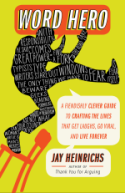“We’re Anesthetizing Our Children”
 Friday, November 19, 2010 at 09:21AM
Friday, November 19, 2010 at 09:21AM Here’s a brilliant lecture, brilliantly animated, on “divergent thinking.” Sir Ken Robinson speaks directly to Figaro’s current dilemma. He (that is, Jay) is writing a book on using figures to make your words memorable. The dilemma: do we open readers up to the richness of possibility—the idea that any one sentence can be written a thousand equally valid ways—or we set hard and fast rules?
On one side, we have the great enlightenment philosopher Desiderius Erasmus. He argued for copia, a celebration of God’s riches through our language. Shakespeare copiously followed this generous philosophy. On the opposite side, we have Strunk & White and education systems. (In his lecture, Sir Ken Robinson even manages to link the ADHD “epidemic” to standardized testing!)
Watch the video, then please advise in the comments.


Reader Comments (22)
I do not see the point of the video as being at odds with Strunk and White. In my own classes, I try to fuse both approaches (hurrah for invention techniques, aka prewriting, which is certainly representative of the "divergent thinking" promoted by Sir Ken Robinson).
I try to explain to my students that there are some nuts and bolts that are their tools - not always that much fun to obtain, but once they have them, they will have even more fun/creativity using them.
It has taken me years to draw up my syllabus, because I have not had the good fortune of coming across an already existing one that I like.
Frank Herbert (yes, I shall now quote "Dune" to spice things up) wrote that "There exists no way of exchanging information without making judgments." I think that it is most useful to represent ideas in categories, even if these categories change as we obtain new information (Edward de Bono wrote about this, in his mind-like-jello and info-like-hot-water-poured-on-mind example). Even Sir Ken Robinson did this in his presentation: as a lecturer, I would not agree with the way in which he prioritised or categorised certain points.
Thus, books I find most helpful are those with some form of categorisation. Quinn's Figures of Speech, while delightful, did not help me retain the figures in my long term memory. Your book, to my mind, was better at that - and if I recall, you did mention in the book that the categorisations you used were merely guidelines.
Ultimately, our knowledge grows with knowledge of new contexts: but if we are teaching the basics (introducing foundations for knowledge or new concepts), we cannot expect students to be well-versed or even be receptive to the multiplicity of possible contexts. (So, lists that have no categories will be too hard for them to deal with; one must first establish a structure on which new ideas can rest.) A reverse approach to structure is the Baconian idol approach: showing those areas in which we are likely to make mistakes in our thinking. So, either one can introduce a new category, or make a category of the area in which students are having difficulty, such as bias, preference, etc.
I predominantly refer to a vague category called "complex or critical thinking," with the disclaimer that we continue to develop these skills throughout our lives. This category's sub-categories include Locke's compare/abstract/combine as well as interpret/assess. I am still working on this.
What I find so fascinating about these techniques is that when I teach them, I so often feel like I am once again reading a Choose Your Own Adventure or Which Way book. I wonder if these concepts could be organised like Cortazar's Hopscotch. These concepts - as you mentioned in your Speech essay - can be conceptualised architecturally, and so ought to be perfectly disposed to the "hypertext" approach, which is not as modern as it seems (then again, neither is the word "modern" modern). This is the approach I would brainstorm if I were to write a book.
Hardy har, asking an audience that includes educators a question leads to the temptation of the soap box! We call that professional deformity (in French). Afraid I couldn't resist, but let us call this Hyde Park and I shall hope this was of help.
In my next book, Word Hero, I divide figures and tropes into three basic categories: Sounds, Pictures, and Associations. There are times when one category works better than another.
But I've found that readers often demand to know what's "right" and "wrong" in each instance. When should you absolutely use a synecdoche, say, and when should you absolutely avoid it? It's the same obsessiveness that has us appalled at the sight of a salad fork placed on the plate side of the dinner fork.
It's reassuring to see that there are educators out there who aren't just looking for the rules. They're giving students the tools.